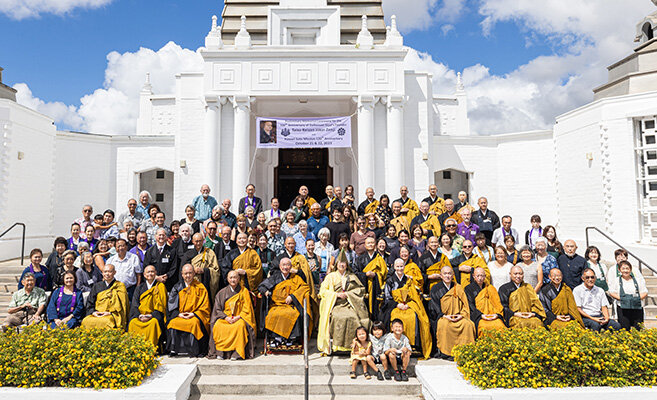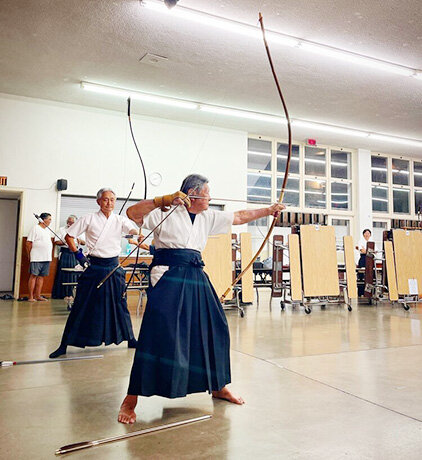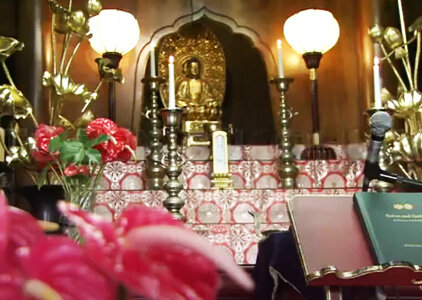Use of Cookies
Our website uses cookies to facilitate and improve your online experience.

Soto Zen Buddhism Hawaii Office (Soto Mission of Hawaii, Shoboji)
In the middle of the Pacific Ocean, Hawaii is where cultural exchanges between East and West have been taking place for many years. Hawaii is also well known for being a tropical paradise and is viewed as the ideal vacation destination by many throughout the world. Hawaii has produced its own unique lifestyle by integrating its own island heritage with several different cultures and customs that were brought over by immigrant groups. Buddhism, which came to Hawaii with the Japanese immigrants, has been a part of the island scene for over a century. Buddhist temples assumed vital roles in meeting the spiritual and cultural needs of the early Japanese immigrants who, in spite of harsh labor conditions, provided the backbone of Hawaii's sugar industry. Today, Hawaii's Japanese-American population mainly consists of the third and the fourth generations. Buddhism continues to play an important role in Hawaii's society. However, it is fairly obvious to everyone that the third and the fourth generations of Japanese-Americans are losing the traditional cultural values and heritage which earlier generations had passed on. In face of this trend, the challenge for today's Buddhist temples is daunting: how to make Buddhism and Japanese tradition relevant and vital to the current and the succeeding generations of Japanese in Hawaii.
Buddhist temples in Hawaii were founded after a contract labor agreement was signed between the Hawaiian government and the Japanese government in 1885. The early immigrants to Hawaii felt the need to have the support of their Buddhist faith and began petitioning their respective headquarter temples in Japan to have Buddhist clergy come to Hawaii. In other cases, Buddhist priests came to Hawaii at their own expense because they were well aware of the struggles of the early immigrants. Those priests lived in the areas from which the immigrants came. (In the case for the Soto Zen School, Hiroshima and Yamaguchi Prefectures were the two areas.) In both cases, temples and meeting halls were built with the funds generated by the early immigrants, and those buildings soon became the home bases for the “Kenjin Kai” or club for the same place of origin. As such, Buddhist temples assumed the Japanese language education for the children of immigrants. Many temples began language schools and Japanese culture classes on their premises. Through such activities, Buddhist priests became not only the spiritual leaders but also the educators of Japanese culture. Also, it is worth mentioning that ministers' wives worked tirelessly along side ministers to assist in carrying out the various duties of the temple.
The Soto Zen School of Buddhism began its propagation effort in much the same way as other schools of Buddhism. The year was 1903 when the first door opened in a few designated locations on all islands. After securing its foundation, in 1921, the Soto Zen School held a major service to commemorate the newly built Honolulu Betsuin, the Headquarter Temple. Arai Sekizen Zenji, the Abbot of Sojiji Head Temple in Japan, came to Hawaii for this occasion. After this auspicious event, Arai Zenji remained in Hawaii, visiting various Soto Zen School temples throughout the islands, and presided over “Jukai-e” (the precepts-initiation ceremonies) for members. Because of his efforts and dedication, he is revered as the pioneer teacher among Hawaii's Soto Zen followers to this day.

Memorial Ceremony for the 700th Anniversary of Daihonzan Sojiji's Founder, Taiso Keizan Jokin Zenji in 2023.
Soto Zen Buddhism Hawaii Office also known as the Bishop Office, is based at the Soto Mission of Hawaii, Shoboji, located next to the Consulate General of Japan, in a central area of Honolulu. Amidst many changes, a total of nine Soto Zen temples and one Zendo serve its members.
The nine temples and one zendo are as follows: Shoboji, Aiea Taiheiji, Waipahu Taiyoji, Wahiawa Ryusenji, Kauai Zenshuji, Maui Mantokuji, Molokai Guzeiji, Hilo Taishoji, Kona Daifukuji and 'Alaneo Zendo.
To date, there have been seven Sokans, who also have served as the head priest at Soto Shu Hawaii Betsuin: Rev. Hosen Isobe (1918 - 1922), Rev. Zenkyo Komagata (1938 - 1970), Rev. Zenshu Komagata (1972 - 1975), Rev. Koryu Oyama (1975 - 1981), Rev. Gyokuei Matsuura (1981 - 1997), Rev. Jiho Machida (1997 - 2008).
Since 2008, the seventh current director, Rev. Shugen Komagata has been serving as the resident priest at the Soto Mission of Hawaii, Shoboji and in the Soto Zen Buddhism Hawaii Office (Bishop Office). Under Rev. Komagata, 'Alaneo Zendo was founded on the Big Island of Hawaii. Also in recent years, several temples successfully celebrated their own respective anniversary. It is still fresh in our memory that Soto Zen School has taken a strong step toward the future.

Cultural Activity, Kyudo (Japanese Archery)
Since its inception, each Soto Zen School's temple in Hawaii has been established and maintained by its own members' financial contributions, and this makes Hawaii's temples unique in that the individual temple is responsible for its own management. However, based on the fact that each temple adheres to the same Soto Zen School doctrines, the organization called Hawaii Soto Mission Association was created. Members of this organization consist of priests and designated temple members (delegates) from each temple. This organization meets twice a year and aims to foster trusting relationships among the temples throughout the Hawaiian Islands. Another important organization is called The United Hawaii Sotoshu Women's Association, which not only serves as an umbrella organization for each temple's Women's Association, but also provides opportunities for women members to exchange ideas so as to take a greater role in each temple's activities. The role of women in local temples is another unique feature of Hawaii's Soto Zen School. It is well known that their contributions are vital to the successful events and activities of each temple.
Throughout its 100-year history, Hawaii's Soto Zen School has consistently followed the “Shushogi” doctrinal principle of living. Especially following Arai Zenji's tour of the Hawaiian Islands, each temple established a “Busshin-Kai” (Buddha Mind Group) and emphasized the practice of “Zenkai Ichinyo” (The unity of Zen and the Precepts). In North America and Europe, the practice of Zazen (sitting meditation) is the focus of Zen outreach. However in Hawaii, Soto Zen priests become a part of the members' lives and take on the role of spiritual guides so that members may achieve peace.

One of the most beloved Japanese cultural events in Hawaii, Bon Dance at Soto Mission of Hawaii.
Currently, the average age of Hawaii's core members is 75-80 years old. There is a sense of urgency in coming up with plans and strategies to add active members of all ages and ethnicities. It is unknown whether or not the next generation will embrace Buddhism (Soto Zen School) since the transition from “the religion of the household” to “the religion of individual” has not fully taken place among Hawaii's Buddhist population. It is imperative that our propagation efforts must be focused on making Buddhism more relevant and familiar to our youth. To achieve this end, Hawaii-born Buddhist priests, who speak the same language and understand the local customs, traditions and lifestyle, are urgently needed. Soto Zen Buddhism Hawaii Office has the duty of producing such priests in order to meet the needs of Hawaii's multi-ethnic population.
Dogen Zenji left Japan and studied in China to further his understanding of Buddhism. Upon his return to Japan, he opened a monastery and trained the next generation of Zen teachers without having to send them to China. The same holds true in Hawaii. By producing our own priests who understand the local tradition and lifestyle, we will be able to establish a Soto Zen School rooted in Hawaii. Soto Zen Buddhism Hawaii Office maintaining close communication with each priest and his/her temple, will continue to make efforts to be the type of institution that brings its members peace.
(Translation by Michael Nakade)
